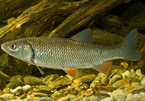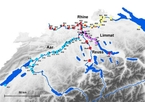News Detail
Fish ladders promote genetic exchange
January 6, 2016 |
The chub is one of the most common fish in Swiss waters, but its name is practically unknown to the general public. And yet this cyprinid fish, which can grow as large as 40 to 50 centimetres in length, can very often be seen close to the river bank, in waterways such as the Schanzengraben, – a picturesque canal in the city of Zurich, or near the Rhine Falls from the small bridge to the restaurant overlooking the river – the Schlössli Wörth. With its bony flesh, the chub seldom makes it to the dining table and so its low economic value is science’s gain.
An ideal model
Up until now, the chub has seldom been stocked in Swiss waters, so the genetic population structure has not been distorted, in contrast to that of the trout. “This makes the chub the ideal model for investigating the extent to which fish ladders at river power plants and other barriers promote genetic exchange between separated populations,” said Alexandre Gouskov, chief author of the Eawag study “Fish population genetic structure shaped by hydroelectric power plants in the upper Rhine catchment”, which appeared recently online in the scientific journal Evolutionary Applications.
There are also other reasons why the chub is especially suited to the investigation being carried out in the Rhine catchment: for one thing this fish species travels great distances during the spawning periods, and in addition it is the only species that is known to use all of the very different fish ladders in the Aare, the Limmat, the Reuss and the Rhine.
Labour-intensive investigation
Switzerland’s watercourses are spanned by many barriers. The report “Strukturen der Fliessgewässer in der Schweiz” (Watercourse structures in Switzerland), published by the Federal Office for the Environment in 2009, highlighted the need for revitalizing 10,800 kilometres of water and 50,000 artificial barriers. The Rhine catchment area investigated by Gouskov and his team includes 37 hydroelectric power plants, two weirs and the Rhine Falls. At the time of the sampling, six of the artificial barriers were not fitted with fish ladders.
For statistical reasons, the researchers took samples at 47 sites. They took approximately 50 chub per site, using electrofishing as an aid. The animals were gently stunned, measured and a small tissue sample was taken from the tail fin. Thereafter they were returned to the water. “The work involved in taking samples for this study was enormous in comparison with other research studies”, says Eawag employee and ETH professor Christoph Vorburger, thus issuing an indirect compliment to Alexandre Gouskov, who undertook the research for his doctoral thesis. The study was largely financed by the Federal Office for the Environment, Eawag and ETH Zurich.
Differentiation effects reduced by fish ladders from 100 to 12 kilometres
From earlier studies it is known that insurmountable barriers have a significant detrimental impact on the genetic population structure of fish. At worst, this isolation can lead to the extinction of a particular population. For this reason, fish ladders are being installed in more and more power plants and other barriers. “We already know, of course, that these ladders are well used by many fish”, said Alexandre Gouskov, “but whether fish ladders actually have a positive effect on the connectivity and genetic diversity of fish populations has not previously been investigated.”
The genetic investigations have enabled the researchers to demonstrate that the fish ladders do, in fact, have a positive impact on genetic exchange. An artificial barrier without fish ladders has as strong an effect on the genetic differentiation of fish as a distance of around 100 kilometres in a barrier-free river. In the case of barriers fitted with fish ladders, the equivalent distance is reduced to around 12 kilometres.
According to Gouskov, this shows that fish ladders improve connectivity of separated fish populations. But even with fish ladders, power plants have a significant effect on the genetic differentiation of the chub. When considered in the light of other fish species, this finding is even more significant, as many species are less able to negotiate fish ladders and are therefore more threatened with fragmentation.
“Our results show that it definitely makes sense to continue the revitalisation measures begun in recent years”, concludes Alexandre Gouskov. “More is needed, including better quality fish ladders, in order to protect the various species.” The design of the ladders determines the extent to which they are used. Bypass channels, for example, have proved more effective than simple concrete stairs. “Many fish ladders have huge potential for improvement”, says Gouskov. During the fieldwork for this study, he was able to see for himself the effect of improvement measures. “The Rheinfelden electric power plant now has a fairly naturally-structured bypass channel with a sizable flow. In the first season alone, around 40,000 fish of 33 different species have used the channel, which is good news, as this is far more than is achieved with conventional-style fish ladders.”
Picture captions



![[Translate to English:] Eawag-Forscher Alexandre Gouskov fischt beim Kraftwerk Dietikon (ZH) nach Alets. Eawag-Kollegin Marta Reyes unterstützt ihn beim Elektrofischen, Foto: Peter Penicka, Eawag [Translate to English:] Eawag-Forscher Alexandre Gouskov fischt beim Kraftwerk Dietikon (ZH) nach Alets. Eawag-Kollegin Marta Reyes unterstützt ihn beim Elektrofischen, Foto: Peter Penicka, Eawag](/fileadmin/_processed_/1/e/csm_A_Gouskov_E_Fischen_beim-Wehr_20151215_1399_WEB_9c2eaddf5d.jpg)

